Dear Readers, Bank Exam Race for the Year 2018 is already started, To enrich your preparation here we have providing new series of Practice Questions on Reasoning Ability – Seating Arrangement.Candidates those who are preparing for IBPS RRB PO Prelims 2018 Exams can practice these questions daily and make your preparation effective.
Click “Start Quiz” to attend these Questions and view Solutions
Click here to view Reasoning Questions in Hindi
Direction (1-5): Study following information carefully and answer the questions given below.
Eight persons-A, B, C, D, E, F, G and H are sitting around a circular table facing center. All of them stay in different floors, viz. 8th, 7th, 6th, 5th, 4th, 3rd, 2nd and 1st, but not necessarily in the same order.
Only one person sits between the one who stays on 6th floor and the one who stay on 8th floor. The one who stays on 1st floor sits to the immediate right of the one who stays on 8th floor. C stays on the 3rd floor. G does not stay on 5th floor and sits to the immediate left of H. A sits second to the left of the one who stays on 7th floor. Only two persons sit between C and the one who stays on 6th floor. B and E are immediate neighbours. The one who stays on the 5th floor sits second to the left of F. H is the immediate neighbour of the one who stays on 5th floor. A and C are not an immediate neighbours. Only two persons sit between the one who stays on 7th floor and the one who stays on 5th floor. E and G are not immediate neighbours. H’s floor is neither 1st nor 2nd.
1). What is the position of D with respect to the one who stays on 8th floor?
- Third to the right
- Second to the right
- Second to the left
- Fourth to the left
- None of these
2). Which of the following statement is correct?
- Only one person sits between the one who stays on 3rd floor and F
- H stays on 6th floor and sits to the immediate left of D
- A stays on the 8th floor and sits to the immediate left of F
- C sits second to the left of G
- None of these
3). Which of the following combinations is correct?
- H-6th floor
- A-8th floor
- F-1st floor
- G- 2nd floor
- None of these
4). How many persons sit between the one who stays on 2nd floor and the one who stays on 4th floor?
- One
- Two
- Three
- No one
- Four
5). What is the position of the one who stays on 4th floor with respect to the one who sits second to the right of the one who stays on 1st floor?
- Immediate right
- Second to the right
- Third to the right
- Fourth to the right
- None of these
Direction (6-10): Study following information carefully and answer the questions given below.
Eight persons are sitting in two parallel rows containing four persons each in such a way that there is equal distance between adjacent persons. In row 1: A, B, C and D are seated and all of them are facing north. In row 2: E, F, G and H are seated and all of them are facing south. Each person in row 1 faces a person of the other row. Each of them likes different English alphabetical letters, viz. S, T, U, V, W, X, Y and Z, but not necessarily in the same order.
The immediate neighbour of G faces the one who likes S. D faces the one who sits to the immediate right of the one who likes X. G does not sit at any extreme ends of the line. E and B are not sitting at any extreme ends of the line. G likes neither V nor X. The one who likes W faces the one who sits to the immediate left of C. Only one person sits between the one who likes T and the one who likes Y but that person is not A. The one who likes U and the one who likes T both are not sit at any extreme ends of the line. The one who likes X faces the one who sits to the immediate left of the one who likes T. H sits to the immediate left of the one who likes W. The one who likes V and the one who likes X are immediate neighbours. C does not like T and U.
6). Which of the following statement is correct?
- B likes S and sits to the immediate left of A.
- A and C are immediate neighbours and C faces the one who likes V.
- Only one person sits between the one who likes Z and the one who faces the one who likes U
- D likes T and sits to the immediate right of the one who likes Y
- None of these
7). Which of the following combinations is correct?
- D-U
- C-S
- E-Z
- F-X
- None of these
8). What is the position of the one who faces second to the left of A with respect to the one who likes Z?
- Immediate right
- Second to the left
- Third to the left
- Third to the right
- None of these
9). Four of the following five are alike in certain way and thus form a group as per the given arrangement. Which of the following does not belong to that group?
- The one who likes V
- The one who likes S
- The one who likes U
- The one who likes Z
- The one who likes Y
10). How many persons sit between the one who faces the person who likes V and the one who faces the person who sits to the immediate left of E?
- One
- Two
- No one
- Three
- None of these
Answers:
Direction (1-5):
- The one who stays on 1st floor sits to the immediate right of the one who stays on 8th
- Only one person sits between the one who stays on 6th floor and the one who stay on 8th
- C stays on the 3rd
- Only two persons sit between C and the one who stays on 6th
- Now we have 3 Cases.

- G does not stay on 5th floor and sits to the immediate left of H.
- H’s floor is neither 1st nor 2nd.
- H is the immediate neighbour of the one who stays on 5th
- Only two persons sit between the one who stays on 7th floor and the one who stays on 5th
- A and C are not an immediate neighbours.
- A sits second to the left of the one who stays on 7th
- From the above condition Case 3 was dropped.
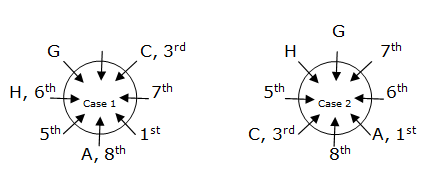
- E and G are not immediate neighbours.
- The one who stays on the 5th floor sits second to the left of F.
- B and E are immediate neighbours, hence Case 1 was dropped.
- H’s floor is neither 1st nor 2nd.
- So the final arrangement is..
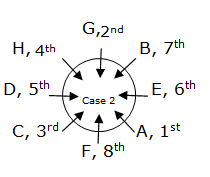
1). Answer: c
2). Answer: e
3). Answer: d
4). Answer: d
5). Answer: b
Direction (6-10):
- The immediate neighbour of G faces the one who likes S.
- G does not sit at any extreme ends of the line.
- The one who likes X faces the one who sits to the immediate left of the one who likes T.
- The one who likes U and the one who likes T both are not sit at any extreme ends of the line.
- G likes neither V nor X.
- D faces the one who sits to the immediate right of the one who likes X.
- Now we have 2 Cases.
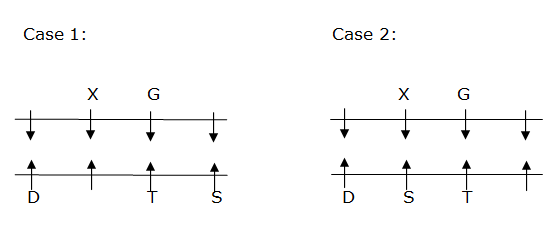
- The one who likes V and the one who likes X are immediate neighbours.
- Only one person sits between the one who likes T and the one who likes Y but that person is not A.
- G likes neither V nor X.
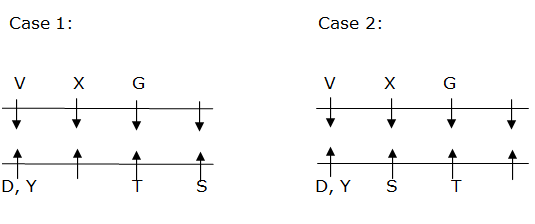
- H sits to the immediate left of the one who likes W.
- The one who likes W faces the one who sits to the immediate left of C.
- C does not likes T and U.
- E and B are not sitting at any extreme ends of the line.
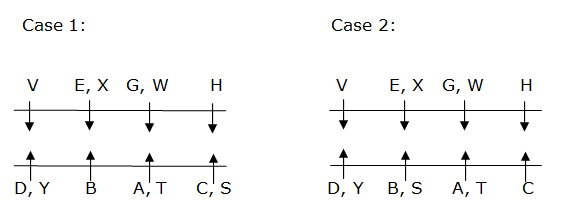
- C does not likes T and U.
- The one who likes U and the one who likes T both are not sit at any extreme ends of the line.
- From the above condition Case 2 was dropped.
- So the final arrangement is..
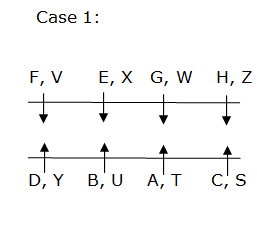
6). Answer: c
7). Answer: b
8). Answer: d
9). Answer: c
10). Answer: a
Daily Practice Test Schedule | Good Luck
| Topic | Daily Publishing Time |
| Daily News Papers & Editorials | 8.00 AM |
| Current Affairs Quiz | 9.00 AM |
| Quantitative Aptitude “20-20” | 11.00 AM |
| Vocabulary (Based on The Hindu) | 12.00 PM |
| General Awareness “20-20” | 1.00 PM |
| English Language “20-20” | 2.00 PM |
| Reasoning Puzzles & Seating | 4.00 PM |
| Daily Current Affairs Updates | 5.00 PM |
| Data Interpretation / Application Sums (Topic Wise) | 6.00 PM |
| Reasoning Ability “20-20” | 7.00 PM |
| English Language (New Pattern Questions) | 8.00 PM |
Click Here for More Practice Puzzles and Seating Arrangement Questions





